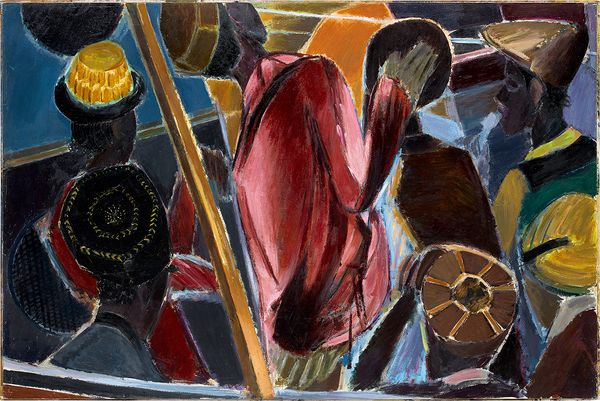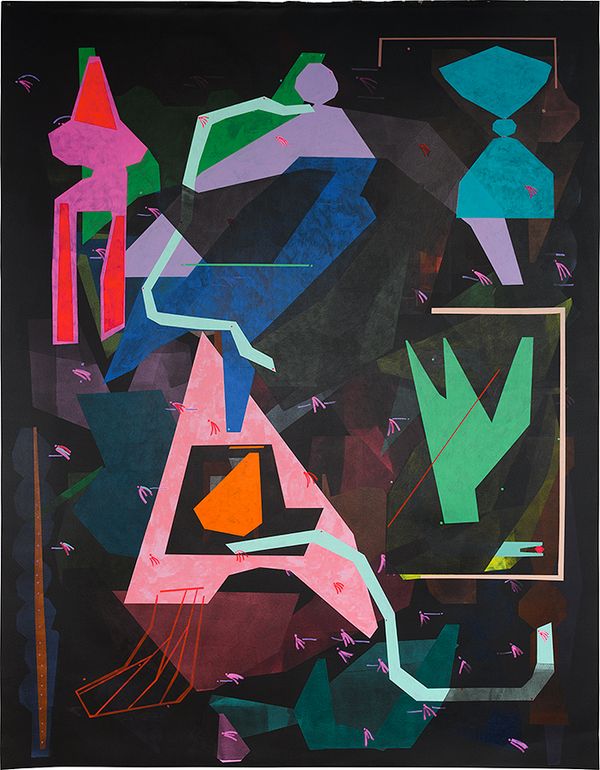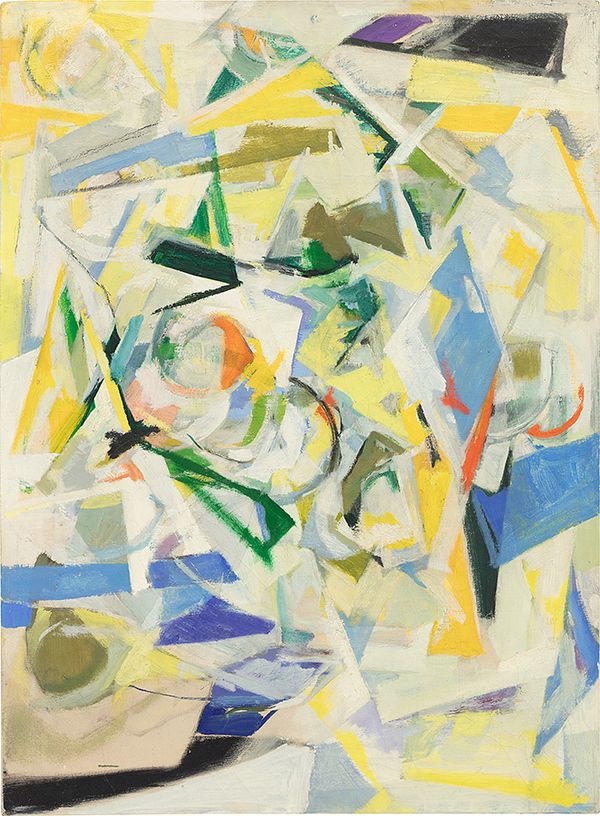Ilana Savdie, Deliberate Rotation of The Nips (y un Manguito), 2021. 20th Century & Contemporary Art Day Sale, Afternoon Session.
Ilana Savdie
Ilana Savdie, Deliberate Rotation of The Nips (y un Manguito) (detail), 2021. 20th Century & Contemporary Art Day Sale, Afternoon Session.
Ilana Savdie’s works operate in the space of the uncanny, intended first to allure and then repel. It’s an expressive mode the artist has described as containing things both familiar and unfamiliar that are never quite resolved, and this 2021 work is perfectly emblematic of her approach. There’s a tension in Savdie’s imagery as the visual forms organically seep into each other through her distinctive technique of pouring oil and acrylic paint and melted beeswax directly onto the canvas. The results are inviting images that express a kind of entanglement and struggle for resolution that resonates with the precocity of contemporary life.
Raised between Barranquilla, Colombia, and Miami, Florida, Savdie draws influence from her early experiences at Colombian Carnival celebrations, pulling imagery from these festivals — including the marimonda figure — as well as from an evolving variety of sources. These sources often include body parts, mythic monsters, and politically satirical caricatures.
Savdie’s distinctive practice has quickly garnered global attention. Through this November, the Whitney Museum of American Art presents her well-received solo exhibition Radical Contractions. Just a year prior, White Cube gallery presented the solo exhibition In Jest and her work has been featured in group exhibitions at the Ballroom Marfa in Marfa, Texas and the Hammer Museum in Los Angeles, among others. She completed her MFA at Yale in 2018 and subsequently received a year-long fellowship at NXTHVN — the residency and community arts incubator formed by artists Titus Kaphar, Jason Price, and Jonathan Brand.
Denzil Forrester
Denzil Forrester, Dub Salute, 1983. 20th Century & Contemporary Art Day Sale, Afternoon Session.
Emigrating from Grenada as a child in the late years of the Windrush Generation, Denzil Forrester settled in London in the late 1960s, eventually finding a sense of community in the dub music scene. The artist fully immersed himself in this scene, making rapid drawings on the bar tops of dub clubs. The drawings would serve as material for paintings that dynamically express the passion of this communal experience, and Dub Salute is a definitive example of this practice from the early 1980s. Through this energetic depiction we can sense the electric energy of the regally attired dancers. We can almost feel the floor vibrating with bass, pierced by the record scratches of DJs such as the famed Jah Shaka, whose distinctive mono sound system Forrester later described as sounding “like a punchbag.”
The artist earned a BA at what is now Central Saint Martins and an MA at the Royal College of Art before accepting a year-long fellowship in Rome. It was while in Rome that Forrester had a painterly revelation, recalling, “I realized that Monet’s waterlilies and Van Gogh’s landscapes were motivated by something simple: painting itself. You have to paint something that means something to you.” This realization solidified his approach, as he fueled his passion for the dub community into further paintings, using the hundreds of drawings he made in clubs while a student as source material for years to come. Yet, the culture at large wasn’t ready. At the time, the art establishment in England was primarily interested in the more conceptual work of the Young British Artists. Forrester later recalled of this era, “If you were a painter, you didn’t stand a chance!” He has spent much of his career painting while teaching three days a week to make ends meet. “I had just enough money to live,” he told Frieze magazine in 2019. “I thought: ‘I’ll just keep going and see what happens.’”
The English artist, curator, and writer Matthew Higgs has suggested that there will be a corrective that introduces Forrester’s work to the art historical narrative of post-war British painting, and recent interest in his work suggests that he’s right. Dub Salute was included in a breakout 2016 exhibition at White Columns in New York, curated by Peter Doig and Higgs. Subsequently, in 2017 a work of his entered the collection of London’s Tate Modern and the following year he joined the roster of Stephen Friedman. Notably, he was honored by the United Kingdom in 2020 as MBE and this year the ICA Miami held a survey of his works dating 1978–1985.
Caroline Kent
Caroline Kent, Out of the solitude and into the daydream, 2022. 20th Century & Contemporary Art Day Sale, Afternoon Session.
The shapes and forms in Caroline Kent’s paintings strike us as directly communicative, but perplexing. It’s as though we’re reading a language only slightly related to one that we speak. The artist has explained that she is “driven by a curiosity to discover where language, abstraction, and painting converge,” further sharing that one of her central inquiries lies in questioning abstract painting’s ability to “act as a carrier of secret communication.”
Kent’s painting process tends to begin with the creation of deep black backgrounds that she refers to as “non-spaces” which act as a site for her visual language to sit within. This contrast imbues her work with a sense that the shapes and forms have emerged from a blankness, illuminated like a secret code the moment before we view. This notion — and her masterful sense of geometry, color, and pattern — is fully on display in Out of the solitude and into the daydream.
Raised in Illinois by a Mexican mother and a Black father, Kent has highlighted her work’s confrontation of abstraction as a field that is historically “almost entirely void of Black and brown voices.” Childhood memories of language barriers and a private language of communication shared with her twin sister also influence her approach: in her abstract language, communicative barriers are broken as every viewer is on equal footing. Rapidly on the rise, Kent’s first institutional solo exhibition, A short play about watching shadows move across the room, will open at the Queens Museum in New York later this year and her work was featured in MoMA’s The Modern Window exhibition series in 2022.
Alice Baber
Alice Baber, Untitled, 1972. 20th Century & Contemporary Art Day Sale, Morning Session.
Painted in the last decade of the artist’s life, Alice Baber’s Untitled from 1972 is emblematic of the vibrant color palette, circular shapes, and movement of light that are essential themes in her work. These rounded shapes overlap and underlap each other, creating a thrilling vibration of color, almost reminiscent of works by Helen Frankenthaler and Vivian Springford. The use of shape and color separates the composition into two planes, giving the background the sense of a halo, rendered in glowing soft tones. Expressing a gentle motion, the forms and colors seem to emerge into the picture plane from the edges — as viewers, it feels as if we’re catching them in the act.
A feminist and tireless advocate for women artists, Baber helped organize several exhibitions of female artists in addition to maintaining her painting practice, including the 1975 exhibition Color, Light, and Image at the Women’s Interart Center in New York. Raised between Illinois and Florida, Baber was educated primarily at Indiana University, where she received an MA in 1951 before eventually settling in New York and Paris and enjoying a successful career. Despite her lifetime achievements, Baber’s works were largely unknown by the greater international community until quite recently, when paintings began to achieve record prices at auction starting last year. Her work is in the permanent collections of several institutions, notably the Guggenheim Museum, the Whitney Museum of American Art, the Museum of Modern Art, and the Corcoran Gallery of Art.
Naudline Pierre
Naudline Pierre, BLT, 2016. 20th Century & Contemporary Art Day Sale, Afternoon Session.
From a distance, Naudline Pierre’s striking 2016 painting BLT appears to be constructed of abstract shapes. On closer look, we discover a cast of characters intimately entangled, so closely intertwined that their outlines often seem to emerge from each other. The young painter, now based in Brooklyn, was raised in Leominster, Massachusetts, in a deeply religious household, her father a protestant Haitian minister. In childhood, her church community believed the apocalypse was imminent. She’s noted that this experience permeates the atmosphere of her work, recently telling BOMB Magazine, “When I was six years old, I thought that by the time I was twelve the earth would be destroyed, and I — if I was righteous enough — would go on to live in a beautiful fantasy world that was beyond my imagination.”
This fantasy world is realized in paintings that depict an enigmatic alternate universe filled with characters who embrace each other in an otherworldly space, outwardly devoid of time as we understand it. One of these characters is a sort of alter ego for the artist, a character she describes as a twin in another universe, offering the artist the agency to imagine experiences for her alter ego that are not possible in her own reality.
The artist also draws from art historical influences — El Greco, William Blake, Hieronymus Bosch, Goya, and Rogier van der Weyden — to recast historic religious iconography within her own mythological world. A rising star, her work was shown this past May at a solo booth at Frieze New York and has been exhibited at the Museum of Contemporary Art in Chicago, New York’s Armory Show, Perrotin Seoul, and Stephen Friedman Gallery in London. She was artist-in-residence at the Studio Museum in Harlem from 2019–2020, and the works created during the residency were shown at MoMA PS1.
Jane Piper
Jane Piper, Study II, 1956. 20th Century & Contemporary Art Day Sale, Morning Session.
Jane Piper’s 1956 Study II comes from a period of the artist’s career during which she prioritized color to push her work past the limits of representation to the edges of abstraction. Her skill as a colorist is prominent in this work, as seen in the diffusion of greens, yellows, blues, and oranges that effortlessly subdue the whites of the background. Color is the organizing principle for much of her work, which builds upon the tradition of Modernist painting.
A lifelong Philadelphian, Piper came from a prominent family and first became interested in painting on a childhood vacation in Cannes, where she observed plein air painters. In her formative years she studied with Earl Horter, Arthur B. Charles, and Hans Hofmann who exposed her to the Modernist painting techniques that would form the foundation of her oeuvre.
Viewing Piper’s work with a contemporary lens offers us the opportunity to reconsider the history of mid-century abstraction, so closely associated with predominantly male artists. Her work has seen continued interest, including through solo shows at galleries throughout the northeast United States. Piper’s work is also in the permanent collections of prominent institutions, including the Philadelphia Museum of Art, the Pennsylvania Academy of Fine Arts, and the Brooklyn Museum.
Allison Katz
Allison Katz, Showery, 2017. 20th Century & Contemporary Art Day Sale, Afternoon Session.
Allison Katz’s Showery was executed for the exhibition Dairy w/o Dates, the first solo exhibition in the United States for the Montreal-born artist, now based in London. The show’s title references her observations of the grid-like construction of both the calendar and the canvas by presenting 12 works that stretch the boundaries of both. In the first presentation of the exhibition at the Oakville Galleries in Ontario, the 12 canvases were installed in the round, allowing the viewer’s scope to take in a maximum of three works in a glance. In contrast, the subsequent exhibition at MIT’s List Visual Arts Center presented the works side-by-side, akin to a timeline.
The duality of these presentations is key to the concept of the series, as it considers time from the perspective of our lived experience, in addition to our memory’s desire to place events on a chronological timeline. It reflects the artist’s questioning of the validity of our sense of time and memory as well as her unique approach to narrative and meaning. As she explained to The White Review, “Because I work in a representational mode there is an assumption about narrative, that the work is ‘about’ something, but that’s not what motivates me. Themes and motifs are generated by, firstly, some form of experience, and then, a method of translation.”
Apart from their size, each work in this series is quite different, confounding any sense of linear narrative. Showery is distinct in the series as a self-portrait in a restrained tonal palette that challenges several art historical allegories at once — the relationship of women to animals and nature and the depiction of the female bather. Since this breakthrough US exhibition, the artist has gone on to feature in the exhibition The Milk of Dreams at the 2022 Venice Biennale. She is now represented by Hauser & Wirth and her hotly anticipated first solo show with the gallery is currently on view in Los Angeles.
Discover More from 20th Century & Contemporary Art >
Recommended Reading







